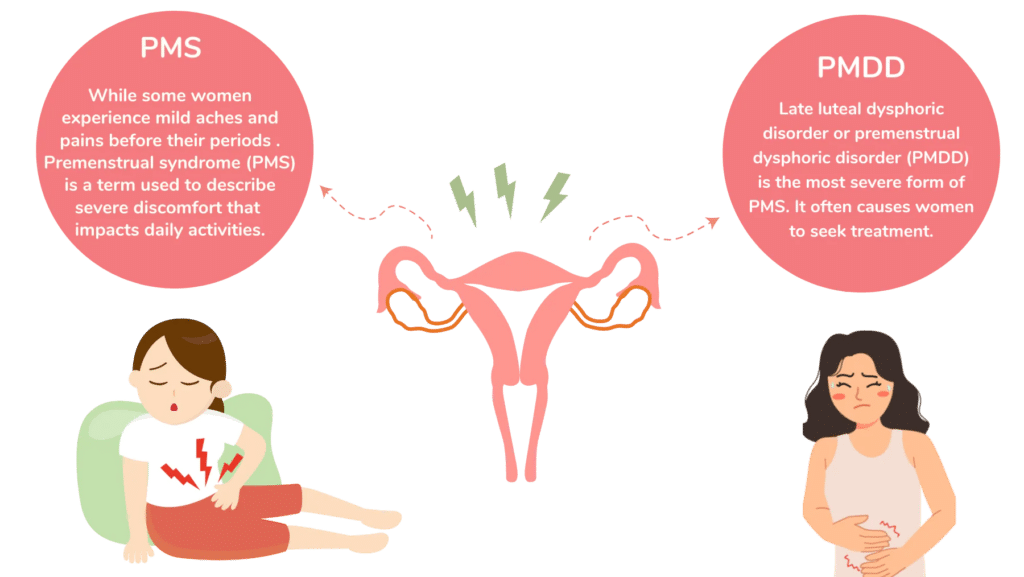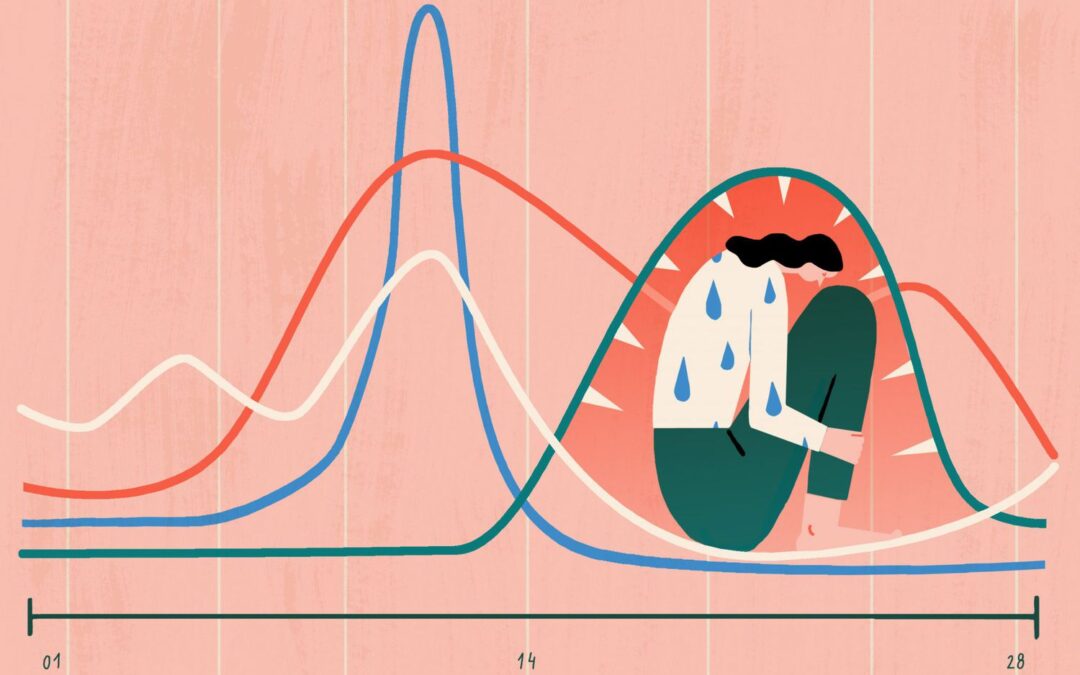Premenstrual dysphoric disorder (PMDD) is a very severe form of premenstrual syndrome (PMS). It causes a range of emotional and physical symptoms every month during the week or two before your period. It is sometimes referred to as ‘severe PMS’.
PMDD occurs during the luteal phase of your menstrual cycle. This is the time between when you ovulate and when your period starts. The luteal phase lasts approximately two weeks for most people but can be longer or shorter.
During this time, you may experience PMDD symptoms every day, or for a few days within the phase. The NHS website has more information on the stages of the menstrual cycle and when they occur.
Many of us may experience symptoms of PMS. But if you have PMDD, these symptoms are much worse and can have a serious impact on your life. Experiencing PMDD can make it difficult to work, socialize and have healthy relationships. In some cases, it can also lead to suicidal thoughts.
What are the symptoms of PMDD?
If you have PMDD, you might find that you experience some of symptoms listed below. But it’s different for different people, so you might also experience other kinds of feelings which aren’t listed here.
Emotional experiences
- mood swings
- feeling upset or tearful
- lack of energy
- less interest in activities you normally enjoy
- feeling hopeless
- suicidal feelings
- feeling angry or irritable
- feeling anxious
- feeling tense or on edge
- feeling overwhelmed or out of control
- difficulty concentrating.
Physical and behavioral experiences
- breast tenderness or swelling
- pain in your muscles and joints
- headaches
- feeling bloated
- changes in your appetite, such as overeating or having specific food cravings
- sleep problems
- increased anger or conflict with people around you
- becoming very upset if you feel that others are rejecting you.
As PMDD is linked to your menstrual cycle, you will likely not experience symptoms if you are pregnant. You may find that the symptoms return once you begin ovulating again though.

What are the causes of PMDD?
The exact causes are still not fully understood but researchers believe that PMDD is caused by being very sensitive to changes in hormone levels. Recent research suggests that PMDD is associated with increased sensitivity to the normal hormonal changes that occur during your monthly menstrual cycle.
There is research to suggest other possible causes for PMDD, as well as things that may make your PMDD worse. Some of these possible factors are:
- Genetics. Some research suggests that increased sensitivity to changes in hormone levels may be caused by genetic variations.
- Smoking. Some research suggests that smoking can have an impact on your hormone sensitivity.
- Trauma and stress. Other research has shown that in some cases PMDD may be linked to stressful and traumatic past events, such as emotional or physical abuse. Stress may also make your PMDD symptoms worse.
Is PMDD a mental health problem?
PMDD is commonly defined as an endocrine disorder, meaning that it is a hormone-related disorder. But as well as physical symptoms, people with PMDD also experience a range of different mental health symptoms such as depression, suicidal feelings and anxiety.
For these reasons, it is listed as a mental health problem in the DSM-5, one of the main manuals that doctors use to categorize and diagnose mental health problems.
Ultimately, it’s important to remember that how you understand your symptoms and experiences is up to you. The most important thing is that you get the support you need and deserve to help you manage the effects of PMDD on your life.
How is PMDD diagnosed?
To get a diagnosis of PMDD the best place to start is visiting your doctor. To help them understand your symptoms your doctor may:
- Ask you to keep a detailed record of your symptoms for at least two months, to see if your symptoms have a pattern over time. This may be in your diary or they may give you some daily questionnaires to fill out.
- Ask you about your medical history, such as any history of mental health problems.
- Ask about your lifestyle, such as if you smoke, drink alcohol or are overweight.
- Give you a physical examination along with some blood tests, so that they can rule out other medical problems.
When you’re asked to keep a record of your symptoms over several months, getting a diagnosis can feel like a very slow process. This can be frustrating if you’re having to wait a long time to get treatment.

What if I’m struggling to get a diagnosis?
Some people find getting a diagnosis of PMDD can be difficult. This might be because it can take a long time to realize that your symptoms follow a cycle and that they are linked to your period. It can also be because PMDD is not very well known, even amongst health professionals. It can be really upsetting and frustrating if you feel like your doctor is overlooking something, or not taking you seriously. There are things you could try though:
- Keep your own detailed record of your symptoms over time. If you have a smartphone, you can download the app Me v PMDD to track your symptoms and cycle. You could also do this in a diary, or you can download mood charts from the internet. The more information you collect over a long period of time, the better prepared you’ll be to explain your symptoms to you doctor.
- Take the PMDD treatment guidelines with you to your primary care physician appointment. The National Institute for Health and Care Excellence (NICE) and the National Association for Premenstrual Syndrome (NAPS) both provide detailed, step-by-step guidelines on the diagnosis and treatment of PMS. These include severe PMS, which is another term for PMDD. You can download these from their websites.
- Ask your PCP if you could speak to a doctor who specializes in mental health, gynecology, or endocrinology. Gynecology is the branch of medicine that deals specifically with the female reproductive system, and endocrinology deals with hormones.
- Consider finding an advocate. An advocate is someone who can come to appointments with you and help make sure people listen to you.
What if I’m trans or non-binary and think I might have PMDD?
If you are trans or non-binary, you can still get PMDD. If you are trans or non-binary, PMDD may increase feelings of discomfort with the gender you were assigned at birth.
You may also find it difficult to talk to a PCP, particularly if you have had a bad experience in the past. You have a right though to be listened to, respected, and given the right support for you.
Premenstrual exacerbation
Your doctor might consider whether you have premenstrual exacerbation (PME) rather than PMDD. This is when existing mental health problems are made worse during the luteal phase of your menstrual cycle. In PME, your symptoms will continue even after your period but at a lower intensity. This is why tracking your symptoms throughout your cycle is important so that you get the right diagnosis.
The International Association for Premenstrual Disorders (IAPMD) has more information on PME on their website.

